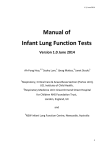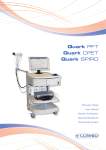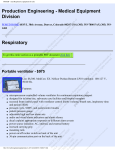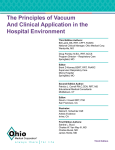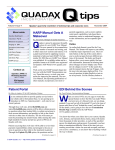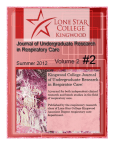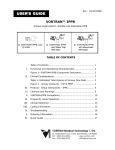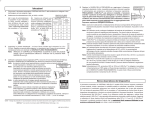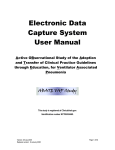Download P-NEB USER GUIDE 2008A
Transcript
VORTRAN Medical Technology 1, Inc. Rev: Rev: 3/5/2008 3/5/2008 USER’S GUIDE P-NEB User’s Guide PercussiveNEB™ (P-NEB) P-NEB is a high frequency intrapulmonary percussive nebulizer intended for the clearance of endobronchial secretions. TABLE OF CONTENTS Table of Contents.................................................. 1 I. Functional and Operational Characteristics ............... 2 Figure 1 – Airway Clearing Technique ...................... 2 II. Clinical Considerations ........................................... 3 Figure 2 - Connect P-NEB to a Flowmeter ................ 4 Figure 3 - Component Description ........................... 5 III. Protocol: Setup Instructions - PercussiveNEB ........... 6 IV. Cautions and Warnings .......................................... 12 V. P-NEB Competency ............................................... 13 VI. Frequently Asked Questions ................................... 14 VII. Clinical Reference ................................................. 16 VIII. Coding Information ............................................... 24 IX. Troubleshooting .................................................... 25 X. Ordering Information ............................................ 25 XI. Quick Guide ......................................................... 26 VORTRAN Medical Technology 1, Inc. 21 Golden Land Court, Sacramento, CA 95834-2426 Tel: (800) 434-4034 www.vortran.com Fax: (916) 648-9751 [email protected] VORTRAN Medical Technology 1, Inc. Rev: 3/5/2008 P-NEB User’s Guide I. Functional and Operational Characteristics The PercussiveNEB is an intrapulmonary percussive treatment device that incorporates a nebulizer to deliver aerosolized medication and is designed to oscillate during exhalation and inhalation to help remove endobronchial secretions. During inhalation, the patient entrains high density aerosol from the nebulizer with high frequency intrapulmonary percussion for enhance aerosol deposition. The moisture and the medication in the aerosol help thin and mobilize secretions. During exhalation the pneumatic capacitor and pulmonary modulator cycle to deliver high frequency (typically 11-30 Hz) pressure bursts to provide an effective intrapulmonary percussion treatment. The high frequency pressure bursts are identical to those delivered by a high frequency ventilator. The bursts or boluses of gas serve to mobilize secretions by creating a gas bolus velocity profile that travels down the center of the bronchial airways (Figure 1). This causes escaping or exhaled gas to travel at high speeds along the wall of the bronchial airways imparting a sizeable force on bronchial secretions moving them up and out of the airways. The P-NEB is designed to oscillate during inhalation for better aerosol deposition and during exhalation to help increase the speed of gas along the walls of the bronchial airways. The pressure bursts also serve to intermittently squeeze the lymph system within the lung increasing the flow rate at which fluids are processed through the lymph system. Figure 1 Airway Clearing Technique Noraml Exhalation without High Frequency Exhalation with High Frequency Page 2 VORTRAN Medical Technology 1, Inc. Rev: 3/5/2008 P-NEB User’s Guide I. Functional and Operational Characteristics OPERATIONAL CHARACTERISTICS Suitable patient body weight .................. Greater than 10 kg Typical percussive oscillation frequency ... Up to 30 Hz (1800 per minute) Device flow ......................................... 43 to 73 L/min Fractional inspired Oxygen (FiO2) ............ Greater than 80% when supplied with 100% O2 Operating environmental limits ............... 5 to 40° C Storage environmental limits ................. -20 to 60° C Patient connection ................................ Mouthpiece Gas inlet ............................................. DISS connection Nebulizer reservoir size ......................... 20 mL Approximate dimensions ....................... 10" x 8" x 3.5" Approximate weight .............................. About 190 grams II. Clinical Considerations The P-NEB is intended to be used only on those patients who are able to breathe spontaneously. The P-NEB is intended to be used with the attached mouthpiece. If a corrugated tube is connected between the mouthpiece and the patient, the pressure bursts received by the patient would be much weaker and dramatically less effective. The P-NEB requires some coordination and training. On inhalation, the patient should be encouraged to inhale as deeply as possible. On exhalation, the patient should be encouraged to exhale slowly and for as long as possible. Because the pressure bursts provide some measure of ventilatory support, patients will usually be comfortable exhaling for longer period of time. Initially, some patients may be tense so the P-NEB may not oscillate as desired. However, as the patient relaxes during exhalation, the P-NEB will be able to function properly. Every patient is different so adjustment of flow and pressure settings, training, and good clinical judgment are all important. Some patients will allow their cheeks to puff out with each pressure burst of the P-NEB. This should be strongly discouraged because it reduces the pressure effect reaching the lungs. The P-NEB nebulizer may be filled with up to 20 mL of liquid. Physicians should select medication carefully to achieve optimal benefits. In any event, it is important that the patient receives moisture during the treatment. Page 3 VORTRAN Medical Technology 1, Inc. Rev: 3/5/2008 P-NEB User’s Guide II. Clinical Considerations (continued) The P-NEB nebulizer has an output during inhalation of approximately 1 mL/ min which depends on the patient’s inhalation efforts. It is recommended that the P-NEB reservoir be filled with 1 mL of inhlation solution for every minute of aerosol treatment. Because on exhalation, when the patient should not be receiving any aerosol, the output is much less. Therefore, the average output during the entire treatment will be less than 1 mL/min. Using 20 mL in the nebulizer reservoir, there will generally be residual liquid left after a 15-20 minute treatment. The gas flow required to operate the P-NEB is typically about 60 L/min. This depends on the patient and the frequency desired. Generally, more airflow will increase the frequency. The most common flowmeters are 15~16 L/min float type flowmeters (Timeter, Puritan Bennett, etc.). When these flowmeters are opened all the way, the float (ball) appears to ride just above the 15~16 L/min mark but in fact is delivering a much higher flow when connected to a P-NEB. In general, the clinician may vary the flow to whatever value is desired. If the P-NEB is oscillating primarily during exhalation at an acceptable frequency, then the P-NEB is receiving the appropriate flow. The PercussiveNEB improvements in ease of use, durability, dependability, and performance attributes has resulted in a device that is more user friendly, reliable, and is adjustable to patient needs. The PercussiveNEB’s pressure dial allows users to set airway pressure oscillation amplitude for individual comfort. It is also quieter, able to oscillate over a wider frequency & pressure range, and is easier to operate within the source flow range. The PercussiveNEB is designed to oscillate at higher frequencies Figure 2 - Connect P-NEB to a flowmeter of 11 to 30 Hz (about 660 to 1800 cycles per minute) for use in the removal of mucus from the lungs of patients with retained endobronchial secretions. The pressure amplitude per oscillation varies with the frequency and the patient but typically ranges from 20 to 40 cm H2O. These peak pressures are difficult for the clinician to monitor with a manometer because the pressure bursts cycle so quickly. Page 4 VORTRAN Medical Technology 1, Inc. Rev: 3/5/2008 P-NEB User’s Guide II. Clinical Considerations (continued) The percent time a positive pressure burst is being delivered to the patient per oscillation is 25-33%. This is equivalent to an I:E ratio ranging from 1:3 to 1:2. This ratio is important because it allows sufficient time for lung and lymph tissue to return to its resting state between pressure bursts. The volume of gas delivered per pressure burst ranges from 35 to 75 mL, depending on frequency and flow rate. The pneumatic capacitor is designed to prevent more then 75 mL per pressure burst, regardless of the patient or settings. When using medication with the P-NEB Nebulizer, the clinician should first add the desired medication to the reservoir and then top off to 15 to 20 mL by adding the necessary volume of saline or respiratory quality water. Treatment times are typically 15 to 20 minutes. It is important when reassembling the P-NEB to screw the nebulizer cap on securely and press the modulator into place firmly. If large leaks exist the PNEB will not function well. The P-NEB may be used with compressed air or oxygen. The P-NEB may be cleaned by washing with mild soap (detergent) followed by rinsing with water and allowing to air dry (see instructions). Figure 3 - Component Description Nebulizer Top Modulator Mouthpiece Nebulizer reservoir (with baffle inside) Amplitude Dial Main column Page 5 VORTRAN Medical Technology 1, Inc. Rev: 3/5/2008 P-NEB User’s Guide III. Protocol: Setup Instructions - PercussiveNEB (HIGH FREQUENCY INTRAPULMONARY PERCUSSIVE NEBULIZER) Policy Number: Institution: Department: Date Adopted: Dates Revised: Dates Reviewed: Approved by: Name: T itle: 1.0 Policy Use of the intrapulmonary percussive nebulizer in an acute care hospital setting. This policy is intended for patients meeting clinical indications for use of the percussive device. This policy is further intended for use by licensed hospital personnel trained in the use of aerosol/ pressure delivery devices. This policy is applicable only upon individual physician order, or with established medical staff approved clinical protocols. For additional information, refer to the manufacturer’s operating manual. 2.0 Purpose To provide clinically appropriate recommendations for the use of the PNEB device, including clinical indications, device set-up, bedside application, potential hazards, and documentation. 3.0 Clinical Logic (New Device Policy) Intrapulmonary Percussive Ventilation is a form of physical therapy, administered to the Pulmonary Airways by a pneumatic device called a “High Frequency Intrapulmonary Percussive Device” (PercussiveNEB). The patient breathes through a mouthpiece which delivers preset driving pressure and frequency. The PercussiveNEB automatically triggers during exhalation to provide intrapulmonary percussion at 11 to 30 Hz (660 to 1800 cycles per minute). The PercussiveNEB delivers PEEP at 2 to 8 cm H2O, aerosol rate during inhalation of 1 mL/min, with aerosol particle size distribution of 2 to 4 mm MMAD. During the percussive bursts of air into the lungs, a continued wedge pressure is maintained, while a high velocity inflow opens airways and enhances endobronchial secretion mobilization. Moreover, the P-NEB is a disposable unit that is useful in such areas as Isolation and Nuclear Medicine. Page 6 VORTRAN Medical Technology 1, Inc. Rev: 3/5/2008 P-NEB User’s Guide III. Protocol: P-NEB (continued) 4.0 Procedure 4.1 4.2 4.3 4.4 4.5 5.0 Contraindications 5.1 5.2 6.0 Indications Mobilization of retained endobronchial secretions Resolution of diffuse patchy atelectasis Acute pulmonary edema Cystic Fibrosis Absolute 5.1.1 tension pneumothorax 5.1.2 acute or high potential of pulmonary hemorrhage 5.1.3 not for patients receiving continuous ventilation Relative 5.2.1 history of pneumothorax 5.2.2 recent lobectomy/pneumonectomy 5.2.3 cardiovascular insufficiency (reduces coronary perfusion) 5.2.4 acute abdominal distention 5.2.5 poor patient cooperation 5.2.6 pulmonary air leak Hazards 6.1 6.2 Effective therapy is accompanied by potential risks. The therapist must be sensitive to potential hazards that may be recognized early and prevented. IPV therapy should normally be discontinued when the patient has received the optimum therapeutic benefit, or when the patient has become fatigued or has requested discontinuation. Therapy must be discontinued if there is any equipment malfunction, and the physician called immediately if any complications arise. Intrapulmonary percussive ventilation treatment will be immediately discontinued and the physician immediately contacted if the patient demonstrates any of (but not limited to) the following adverse reactions: 6.2.1 increased bronchospasm 6.2.2 increased WOB/SOB with therapy 6.2.3 any sign of hypertension or hypotension 6.2.4 any indication of pneumothorax 6.2.5 any indication of allergic reaction to the medicine, diluent, or device component Page 7 VORTRAN Medical Technology 1, Inc. Rev: 3/5/2008 P-NEB User’s Guide III. Protocol: P-NEB (continued) 6.2.6 increased HR > 20 beats/min from baseline value 6.2.7 decreased SpO2 < 92%, or increasing FI O2 requirement with therapy 6.2.8 nausea, vomiting 6.2.9 increase in abdominal distention or discomfort 6.2.10any unexpected increase in hemoptysis 6.2.11onset of dysrhythmia during therapy 6.3 Equipment 6.3.1 PercussiveNEB device 6.3.2 Nippled oxygen tubing (comes with device) 6.3.3 Gas inlet (CA or O2) 6.3.4 Flowmeter 6.4 Device Set-up 6.4.1 Remove PercussiveNEB from packaging. 6.4.2 Place prescribed amount of medication into nebulizer and dilute with saline to obtain desired total volume of liquid. NOTE:The aerosol output of the PercussiveNEB is dependent on the patient’s breathing pattern. The patient entrains air through the nebulizer during inhalation allowing for the maximum dose of medication. There should be 1 mL of fluid in the nebulizer reservoir for approximately every 1 minute of treatment. (NEBULIZER RESERVOIR = 20 mL). 6.4.3 Connect oxygen tubing to flow source and set initial flow using a CONNECT flow meter that covers the range from 0 -75 L/min (such as a Timeter ClassicTM Series Flowmeter 0-75 L/ min Model # A-75 for air or Model # O-75 for oxygen, Allied Healthcare Products, Inc.) 6.5 Orders 6.5.1 Check patient’s chart for airway clearance order, including medications and frequency. Page 8 VORTRAN Medical Technology 1, Inc. Rev: 3/5/2008 P-NEB User’s Guide III. Protocol: P-NEB (continued) 6.6 Patient Instructions/Assessment 6.6.1 Explain the purpose and rationale to the patient/family prior to initiating treatment. Continue to assess/supplement the patient’s understanding of the therapy at subsequent treatments. 6.6.2 Position the patient in an upright, comfortable position, and provide appropriate supplemental O2 as indicated to keep Sp O2 > 92% or as prescribed. 6.6.3 Patient pre-treatment assessment will include full “Respiratory Care Assessment” with subsequent reassessment q day. 6.7 Instructions 6.7.1 Perform a FUNCTIONAL CHECK by occluding the mouthpiece and adjusting flow until oscillation begins. Patients will require greater flow during treatment. DO NOT use if device fails to oscillate. NOTE: The normal flow rate for PercussiveNEB is 60 L/min (+ 25%). The majority of the flow is used for operating the internal components and is not delivered to the patient. 6.7.2 Place the mouthpiece in patient's mouth. Instruct the patient to breathe through the mouth, not the nose. Best results are achieved when the patient is relaxed and breathing normally. The PercussiveNEB will oscillate during exhalation and inhalation. 6.7.3 Adjust flow rate as required until the modulator piston is heard or seen to be oscillating during exhalation. For best results, adjust the flow to accommodate patient's comfort and breathing pattern. ADJUST FLOW RATE PATIENT Page 9 VORTRAN Medical Technology 1, Inc. Rev: 3/5/2008 P-NEB User’s Guide III. Protocol: P-NEB (continued) 6.7.4 Adjust oscillating amplitude as needed for patient's comfort and percussine effects. For best results, start at SOFT setting and gradually increase to HARD setting to accommodate patient's needs and breathing pattern. NOTE: Positive End Expiratory Pressure (PEEP) is intrinsic to this device. Baseline pressure can reach up to 8 cm H2O. ADJUST AMPLITUDE ENLARGED VIEW HARD SOFT 6.8 Assessing Therapeutic Benefit 6.8.1 Increased secretion mobilization 6.8.2 Decreased WOB following therapy 6.8.3 Decreased bronchospasm 6.8.4 Increased inspiratory capacity 6.9 Documentation 6.9.1 Airway clearance therapy will be documented in the appropriate area; i.e. Golden Rod or Phamis charting system, and will include the following: 6.9.1.1 Patient name, account #. 6.9.1.2 Date/time of Rx. 6.9.1.3 Therapeutic objectives, tolerance, benefits, and adverse reaction to therapy. 6.9.1.4 Medication/diluent delivered. 6.9.1.5 Type of therapy/device. 6.9.1.6 HR, RR, and B/S (before, during, and after). 6.9.1.7 Cough evaluation/secretion clearance (amount, color, consistency). 6.9.1.8 RCP name. 6.9.2 Billing – billing will be done according to standard regional cardiopulmonary billing procedures for airway clearance therapy. Page 10 VORTRAN Medical Technology 1, Inc. Rev: 3/5/2008 P-NEB User’s Guide III. Protocol: P-NEB (continued) 6.10 Cleaning 6.10.1 The PercussiveNEB is intended to be used on a single patient only. 6.10.2 To disassemble: 6.10.2.1 Remove modulator from main column. 6.10.2.2 Rotate nebulizer top counterclockwise ¼ turn and lift up to remove. 6.10.2.3 Remove baffle from reservoir. 6.10.2.4 Wash all components using soapy water (detergent) and rinse throughly after every treatment. Allow to air dry before reassembly. 6.10.2.5 Clean the modulator by running water through Cleaning the smaller port, using a Rod cleaning rod to push the piston up and down in the large port. Allow water to flush through the modulator, cleaning Piston the piston. Shake dry Assembly and repeat. NOTE: The PercussiveNEB performance will degrade if the modulator is not adequately cleaned. 6.10.3 To reassemble: 6.10.3.1 Reassemble in the reverse order of Steps 1 through 3. 6.10.3.2 Make sure all components are firmly in place. 6.10.3.3 The PercussiveNEB is now ready to use. Nebulizer Top Modulator Mouthpiece Nebulizer reservoir (with baffle inside) Amplitude Dial Main column Page 11 VORTRAN Medical Technology 1, Inc. Rev: 3/5/2008 P-NEB User’s Guide IV. Cautions and Warnings Cautions 1. Positive End Expiratory Pressure (PEEP) is intrinsic to this device. Typical baseline pressure can reach up to 8 cm H2O. 2. To be used only by persons having adequate training. Warnings Not for patients receiving continuous ventilation. Page 12 VORTRAN Medical 1, Inc. Greater than 80% Technology when Rev: 3/5/2008 P-NEB User’s Guide V. P-NEB Competency How to set up and use the PercussiveNEB - a new and unique single patient intrapulmonary percussive ventilation device used for clearing endobronchial secretions from patients’ airways. Objectives 1. To be able to set up, clean and care for the PercussiveNEB and know the optimal flow setting and gas source requirements. 2. To understand the mechanism of intrapulmonary percussion ventilation - frequency (11 to 30 Hz) and pressure amplitude (PIP and PEP). 3. To know the characteristics of the aerosol components (medication and saline) of the PercussiveNEB. Troubleshooting the PercussiveNEB 1. The flow is the only power source for the PercussiveNEB. Higher flow means more percussive effect and higher frequency. [ ] True [ ] False 2. If the nebulizer has an output of 1 mL/min and there is still liquid in the reservoir after a 20-minute treatment, should all the liquid be gone? [ ] Yes [ ] No After completion of the PercussiveNEB competency, the Respiratory Care Practitioner should be able to set up the PercussiveNEB and troubleshoot problems that may arise during its use. Name Department Institution: Dates Completed: Page 13 VORTRAN Medical Technology 1, Inc. Rev: 3/5/2008 P-NEB User’s Guide VI. FAQ (Frequently Asked Questions) Question Answer 1. The PercussiveNEB is cycling occasionally during inhalation. Is this a problem? No, this is not a problem. It occurs when adjusting the flow to a setting that produces a high rate of cycling during exhalation. 2. The PercussiveNEB is cycling primarily during inhalation. What is wrong? The flow rate is set too high. Reduce the flow. If you are connected directly to a 50 PSIG source, you will have to use a flow meter or a pressure regulator 3. The PercussiveNEB was working fine on prior treatments and is now not cycling well. What’s wrong? It is important to assemble the PecussiveNEB tightly. If a large leak is present, it will not work as well. This is particularly important after cleaning. Be sure the nebulizer cap is screwed on tightly and that the modulator has been pushed firmly into place. Lastly, ensure that you are providing adequate flow. 4. Can I connect the PercussiveNEB directly to a wall source of 50 PSIG? It depends. As long as the PercussiveNEB is cycling during exhalation at a rate appropriate for clearance and is well tolerated by the patient, then the flow is acceptable. If not, a flow meter will need to be used. 5. All I have are 15 L/ min flowmeters. How can I use the PercussiveNEB? All float/ball type 15 L/min flowmeters tested by VORTRAN Medical Technology 1 will provide sufficient flow when dialed all the way open. Under such circumstances the ball indicates a flow only slightly higher then 15 L/min, but it is actually delivering a lot more flow. 6. I have a patient who needs to use the PercussiveNEB at home. Will it work with the Pulmoaide? No. Compressors designed for small volume nebulizer treatments are not capable of delivering the needed flow. Most hospital equipment rental agencies rent compressors large enough to power a ventilator. This is needed for the PercussiveNEB. You will also probably want to equip the compressor with a flow meter. Page 14 VORTRAN Medical Technology 1, Inc. Rev: 3/5/2008 P-NEB User’s Guide VI. FAQ (continued) Question Answer 7. How much and what kinds of medication do I place in the nebulizer? How do I get 20 ml of fluid in the nebulizer? A physician must prescribe the type of medication and the amount for each treatment. Commonly used medications are Beta2 agonists, anticholinergics, and mucolytics. To mix the medication, first place the prescribed amount of medication into the nebulizer reservoir. Then add saline or respiratory quality water to make a total volume of 20 mL. 8. After a 20-minute treatment I still have liquid in the nebulizer reservoir. If the nebulizer has an output rate of 1 ml/ min, shouldn’t all the liquid be gone? The nebulizer has an output of 1 mL/min during inhalation when the patient is actually receiving aerosol. During exhalation the output of the nebulizer is less so it is normal to have liquid left over in the reservoir. Actual outputs will vary with each patient. It is important that liquid is present in the nebulizer reservoir during the entire course of treatment. 9. What is re-usable in PercussiveNEB? The PercussiveNEB is single patient, multiple use and totally disposable. 10.How long will my PercussiveNEB last? Under normal operating condition, your device should last about 100 hours of operation. If you do two - 15 minutes per day, it will last about 90 days. Page 15 VORTRAN Medical Technology 1, Inc. Rev: 3/5/2008 P-NEB User’s Guide VII. Clinical Reference RL Chatburn; HIGH-FREQUENCY ASSISTED AIRWAY CLEARANCE, Respiratory Care 2007;52(9):1224–1235. Summary High-frequency airway clearance assist devices generate either positive or negative transrespiratory pressure excursions to produce high-frequency, small-volume oscillations in the airways. Intrapulmonary percussive ventilation creates a positive transrespiratory pressure by injecting short, rapid inspiratory flow pulses into the airway opening and relies on chest wall elastic recoil for passive exhalation. High-frequency chest wall compression generates a negative transrespiratory pressure by compressing the chest externally to cause short, rapid expiratory flow pulses, and relies on chest wall elastic recoil to return the lungs to functional residual capacity. High-frequency chest wall oscillation uses a chest cuirass to generate biphasic changes in transrespiratory pressure. In any case (positive or negative pressure pulses or both), the general idea is get air behind secretions and move them toward the larger airways, where they can be coughed up and expectorated. These techniques have become ubiquitous enough to constitute a standard of care. Yet, despite over 20 years of research, clinical evidence of efficacy for them is still lacking. Indeed, there is insufficient evidence to support the use of any single airway clearance technique, let alone judge any one of them superior. Aside from patient preference and capability, cost-effectiveness studies based on existing clinical data are necessary to determine when a given technique is most practical. Key words: high frequency, airway clearance, secretion removal, intrapulmonary percussive ventilation, high-frequency chest wall compression, high-frequency chest wall oscillation. [Respir Care 2007;52(9):1224–1235. © 2007 Daedalus Enterprises] Robert L Chatburn RRT-NPS FAARC is affiliated with the Section of Respiratory Care, Cleveland Clinic, Cleveland, Ohio, and with the Department of Medicine, Lerner College of Medicine, Case Western Reserve University, Cleveland, Ohio. PILOT STUDY:PERCUSSIVE NEBULIZER VS. TRADITIONAL BRONCHIAL HYGIENE THERAPY FOR TREATMENT OF POST OPERATIVE ATELECTSIS IN CARDIAC SURGERY PATIENTS John Garcia, RRT, Kasem Loui, RRT, NPS, Luis Moreta-Sainz, MD. Kaiser Permanente Los Angeles Medical Center, Los Angeles, CA. Presented at 50th AARC International Rspiratory Congress in New Orleans, LA., Dec 4-7, 2004 BACKGROUND: Kaiser Permanente Los Angeles Medical Center is the regional tertiary care center for cardiac surgery. A well known complication of cardiac surgery is post-operative atelectasis. The traditional bronchial hygiene therapy approach to post-operative atelectasis includes intermittent positive pressure breathing (IPPB) treatments followed by chest physiotherapy (CPT). Traditional therapy is extremely labor intensive and has in our experience demonstrated marginal clinical efficacy. Moreover, the traditional bronchial approaches to post-operative atelectasis are inconsistent with our evidence based practice model. Therefore a pilot study was conducted utilizing a disposable single patient use percussive nebulizer (PN). METHOD: 26 post-operative cardiac surgery patients who met our treatment criteria for post-operative atelectasis were placed on PN therapy and evaluated: Our treatment criteria for both groups included: increasing fiO2 requirements, ABG demonstrating hypoxemia and/or hypercarbia with or without acidosis, and chest x-rays (CXR) showing atelectasis or infiltrates. Clinical improvement was defined as: clearing or improved CXR, and a decreasing fiO2 requirement with an average fiO2 of .25 and SpO2 of 96%. RESULTS: All 26 patients in the PN group presented with atelectasis on CXR and were receiving high levels supplemental oxygen with an average fiO2 of .60 pre PN therapy. Of these patients, 24 showed clinical improvement in an average of 3 days. There were two PN treatment failures, one due to late intervention and another due to cardiac failure. Both patients required reintubation and mechanical ventilation. EXPERIENCE: PN appears to be a viable alternative to our traditional bronchial hygiene regimen though a more thorough investigation should be undertaken. CONCLUSIONS: Treatment of atelectasis in post-operative cardiac surgery patients with PN appears to be a more effective and efficient use of departmental resources than traditional bronchial hygiene procedures. Page 16 VORTRAN Medical Technology 1, Inc. Rev: 3/5/2008 P-NEB User’s Guide VII. Clinical Reference (continued) Finder, Jonathan MD; Airway Clearance Techniques - Trends in the Treatment of Lung Diseases, Respiratory Magazine, Issue: November 2007. CPT has been the standard for CF care since the 1960s, but newer techniques are finding acceptance, too. In respiratory medicine, one constant theme is the importance of airway clearance in maintaining health. Airway (secretion) clearance consists of two linked systems: mucociliary clearance and cough clearance. Oscillation Devices High-frequency chest-wall oscillation (CWO), as a term, should not be used interchangeably with HFCC. High-frequency CWO refers to the Hayek Oscillator™ (Breasy Medical Equipment, Charlotte, NC), which is a negative-pressure ventilator that uses a cuirass interface around the chest. Just one study 15 using this device in CF has been published, and the authors found that it was not as effective as techniques using the active cycle of breathing; they concluded that high-frequency CWO was not an effective airway-clearance modality in CF exacerbations. Just as HFCC oscillates the air within the lung, handheld devices that oscillate a column of air within the airway help to shear secretions away from the wall of the airway and help mobilize them for expectoration. They are similar in function to HFCC. One difference, though, is that handheld oral airway oscillators generally provide some positive airway pressure to help maintain airway patency during breathing. Therefore, they are often discussed in the context of PEP. The first reports16 on oral airway oscillation demonstrated an increase in expectorated sputum volume, compared with conventional CPT. The original device (Flutter, Axcan Pharma, Birmingham, Ala) used a metal ball that oscillated based on gravity, and therefore was quite positionally sensitive. Later devices used magnetic attraction to open and close the valve (Acapella, Smiths Medical, Waukesha, Wis) or a hand-cranked mechanism to open and close a valve (Quake, Thayer Medical Corp, Tucson, Ariz), thereby rapidly opening and closing the airway’s opening during expiration. The hand-cranked device also has the advantage of allowing airway oscillation during the inspiratory phase, and it does not rely on a high flow rate for function. This device may be more useful in patients with more severe obstructive defects. No head-to-head studies of these devices have ever been performed. Two other devices, which were designed for hospital use, also deliver nebulized medications via positive, oscillating pressure: the PercussiveNEB® (Vortran, Sacramento, Calif) and intrapulmonary percussive ventilation (IPV®, Percussionaire, Sandpoint, Idaho). The PercussiveNEB has not been shown to be effective, and its use remains limited. IPV uses small, rapid, high-flow bursts of air to help loosen secretions; it has been studied17,18in patients with neuromuscular weakness and atelectasis. Anecdotal reports have indicated that IPV is a useful adjunct in clearing atelectasis in patients with neuromuscular weakness. IPV has also been evaluated19 in CF in comparison with the Flutter and CPT. No differences were found, suggesting that IPV is no less effective than other forms of airway clearance. IPV was also well tolerated. The largest study group consisted of 16 subjects, limiting, to some degree, the usefulness of this work. Despite these promising reports from the mid 1990s, no larger follow-up studies have been published. Jonathan Finder, MD, is associate professor of pediatrics, University of Pittsburgh. Page 17 VORTRAN Medical Technology 1, Inc. Rev: 3/5/2008 P-NEB User’s Guide VII. Clinical Reference (continued) PercussiveNEB™ (P-NEB) COST COMPARISON Therapy time Cost for therapist Labor cost per TX Equipment Cost of equipment P-NEB™ with Aerosol P. D. & P. with Aerosol TX Flutter ® with Aerosol TX 15 minutes $30.00 / hour $7.50 P-NEB™ $72.00 45 minutes $30.00 / hour $22.50 Nebulizer $2.00 30 minutes $30.00 / hour $15.00 Flutter & Nebulizer $55.00 Estimated Cost (Daily - Based on QID) $72 + ($7.50 X 4) = $2 + ($22.50 X 4) = $55 + ($15 X 4) = Cost - 1 day $102 $92 $115 $72 + ($7.50 X 8) = $2 + ($22.50 X 8) = $55 + ($15 X 8) = Cost - 2 days $132 $182 $175 $72 + ($7.50 X 12) = $2 + ($22.50 X 12) = $55 + ($15 X 12) = Cost - 3 days $162 $272 $235 BENEFITS COMPARISON P-NEB™ P. D. & P. Flutter ® with Aerosol with Aerosol TX with Aerosol TX Needs therapist No Yes No Therapy consistency Yes No No Ease of use Fully automatic Needs therapist Needs adequate TV & QEXP Patient tolerance Good Not tolerated by all Good PULMONARY FUNCTION AND SPUTUM PRODUCTION IN PATIENTS WITH CYSTIC FIBROSIS* A PILOT STUDY COMPARING THE PERCUSSIVETECH HF DEVICE AND STANDARD CHEST PHYSIOTHERAPY. John H. Marks, MD, FCCP; Karyl L. Hare, RN, CDE; Robert A. Saunders, RRT and Douglas N. Homnick, MD, MPH, FCCP, et al. American College of Chest Physicians Chest. 2004;125:1507-1511.* From the Pediatric Pulmonary Division, Department of Pediatrics, Michigan State University, Kalamazoo Center for Medical Studies (Drs. Marks and Homnick, and Ms. Hare), and Pulmonary Function Laboratory, Bronson Methodist Hospital (Mr. Saunders), Kalamazoo, MI. Study objective: To compare the PercussiveTech HF (PTHF) device (Vortran Medical Technology 1; Sacramento, CA) to standard manual chest physiotherapy (CPT) with respect to acute changes in pulmonary function, sputum production, and pulse oximetry in patients with cystic fibrosis (CF). Design: Randomized crossover. Setting: University-affiliated, community-based CF center. Participants: Ten clinically stable patients with CF (age range, 10 to 21 years; mean age, 15.3 years) with Shwachman scores from 55 to 95 (mean 75). Interventions: Two treatment regimens were used: 2.5 mg of albuterol delivered via updraft nebulizer followed by standard CPT, and 2.5 mg of albuterol delivered via the PTHF device without CPT. Results: Outcome measures included pulmonary function test (PFT) results 4 h after treatment and quantitative sputum production during the 4 h after treatment. Pulse oximetry was performed during treatment. A patient satisfaction questionnaire was administered at the end of the study. No PFT parameters were significantly changed 4 h after CPT or PTHF, although there was a trend to decreasing residual volume after both treatments. There was a trend for more sputum production after PTHF compared to CPT, but this did not reach statistical significance. There were no episodes of hemoglobin-oxygen desaturation during or after either treatment. One patient had minor hemoptysis after CPT. No adverse effects occurred after PTHF. Eight patients found the PTHF device easy to use, and six patients would prefer the PTHF device to CPT. Conclusions: The PTHF device appears to be a safe and effective method of airway clearance in CF patients in this small pilot study. Page 18 VORTRAN Medical Technology 1, Inc. Rev: 3/5/2008 P-NEB User’s Guide VII. Clinical Reference (continued) J. H. Marks; D. N. Homnick; K. Hare; D. Cucos; THE PERCUSSIVETECH HF COMPARED TO THE FLUTTER DEVICE IN CYSTIC FIBROSIS PATIENTS: A SIX MONTH PILOT STUDY, Presented at 2001 North American Cystic Fibrosis Conference, Orlando World Center Marriott, Orlando, Florida, Oct 25-28, 2001. Airway clearance devices, such as the Flutter or Intrapulmonary Percussive Ventilator, are accepted airway clearance methods for CF patients. The PercussiveTech-HF(PTHF) is an intrapulmonary percussive treatment device that also delivers a large volume (20ml) aerosol. The PTHF oscillates primarily during exhalation providing intrapulmonary percussion at 6 to 14 Hz with positive expiratory pressure of 10-20 cm H2O. In a pilot study of the PTHF device we showed safety and effectiveness compared to standard chest physiotherapy.* Aims: This study compared the longterm effects of twice-daily use of the PTHF device with the Flutter device in patients with CF. Outcome measures included FEV1(primary), FVC, FEF25-75, number of days of hospitalization, lost school or work, and IV antibiotic use. A patient satisfaction questionnaire was given to the PTHF group. Methods: Sixteen patients were randomized to either Flutter (3F, 5M) or the PTHF (4F, 4M). At enrollment spirometry and Shwachman score were obtained. All subjects then completed one week of twice-daily Flutter treatments. After day 7 baseline spirometry was obtained, the PTHF group started twice-daily treatments while the Flutter group continued twice-daily Flutter treatments. All patients received 2.5mg of albuterol in saline, 20ml in the PTHF group, and 3ml in the Flutter group, with each treatment. Spirometry was repeated every 4 weeks until the end of the study at 24 weeks. Pulmonary exacerbations requiring hospitalization or home IV antibiotics were noted. PTHF questionnaires were completed at each visit. Results: Fifteen patients completed the 24 week study, 8 Flutter, 7 PTHF. One became pregnant and was excluded. Both groups had a similar mean age (95%confidence interval (CI)) Flutter 14.1(10.5;18), PTHF 10.9(8.4;13.3) and Shwachman score, Flutter 72.6(62;83), PTHF 79.6(68;91). There were no significant differences between groups at day 7 baseline for mean per cent predicted FEV1 -Flutter 56% (41;71) and PTHF 75.6% (53;98) p=.208, or FVC- Flutter 78% (60;96), PTHF 90.6% (70;111), p=.292, or FEF25-75- Flutter 30% (16;44) and PTHF 58% (28;89), p=.0513. At week 24 there were no significant differences between groups in FEV1(p=.208), FVC(p=.292), or FEF25-75 (p=.126). Within groups there is no significant difference between baseline and week 24 for FEV1 - Flutter p=.98, PTHF p=.471, FVC- Flutter p=.717, or the PTHF group p=.149, or FEF25-75 - Flutter p=.697, PTHF p=.29. There were no differences between groups in the mean number of hospital or home IV antibiotic days. Patient satisfaction with the PTHF treatments was good, with 67% of patients willing to continue using the PTHF instead of other airway clearance methods. Conclusions: The PTHF device was well tolerated and generally well accepted as as an airway clearance method by CF patients in this 6 month pilot study. The PTHF may be as effective as the Flutter device, however, larger studies are needed to assure the long-term effectiveness. *Marks JH, Homnick DN. Pediatr Pulmonol 1999; Suppl.19:290. Supported by Vortran Medical Technolog 1, Inc. Page 19 VORTRAN Medical Technology 1, Inc. Rev: 3/5/2008 P-NEB User’s Guide VII. Clinical Reference (continued) Marks, John H 1, Hare KL1, Homnick DN1., PULMONARY FUNCTION AND SPUTUM PRODUCTION IN PATIENTS WITH CYSTIC FIBROSIS: A PILOT STUDY COMPARING THE PERCUSSIVETECH HF DEVICE AND STANDARD CHEST PHYSIOTHERAPY, (1. Michigan State University, Kalamazoo Center for Medical Studies, Kalamazoo, MI, USA.), Accepted for presentation at 13th Annual North American Cystic Fibrosis Conference in Seattle, Washington, October 710, 1999. Abstract: Manual chest physiotherapy with gravity assisted drainage (CPT) continues to be the standard method of airway clearance for patients with cystic fibrosis (CF). While CPT has long been shown to aid in clearance of pulmonary secretions in CF patients, compliance in the daily regimens of therapy are often an issue due to time involved and the need for assistance in such therapy. Several devices have been shown to be effective in aiding airway clearance in CF patients, including positive expiratory pressure (PEP), the flutter device, high frequency chest wall compression vest and the intrapulmonary percussive (IPV). We have previously reported on the effectiveness of the IPV compared to CPT and the flutter device. This study compares a new airway clearance device, the PercussiveTech HF (PTHF), with CPT in patients with CF. The PercussiveTech HF device delivers rapid, mini-bursts of air (intrapulmonary percussion) with high volume aerosol delivery. Ten clinically stable patients with CF (age 10 to 21 years) were randomized to receive PTHF or CPT regimens on one day with crossover to the alternate treatment one week later. Regimens included 2.5 mg albuterol in 2 cc NS by standard nebulizer followed by standard chest physiotherapy using CFF guidelines, or 2.5 mg albuterol in 15-20 cc NS by the PTHF device without CPT. Compressed air was used for the standard nebulizer and the PTHF and pulse oximetry was monitored during each treatment. Baseline pulmonary function (PFTs), including FVC, FEVI, FEF25-75, TLC, RV, were obtained prior to each treatment. Repeat PFTs were performed 4 hours after completing each regimen and sputum was collected over the 4 hour period. Sputum was collected with the use of cotton wool dental dams. Sputum wet and dry weights were measured. Nine participants completed the study. No PFT parameters were significantly changed after CPT or PTHF, although there was a trend to decreasing RV after both therapies. There was a trend for more sputum production after PTHF compared to CPT, mean wet weight 13.72 gm vs 7.75 gm and dry weight 1.47 gm vs 0.51 gm, but this did not reach statistical significance. There were no adverse events during or after either therapy except for minor hemoptysis in one patient after CPT. Eight patients found the PTHF easy to use and six would prefer it over CPT. Douglas N. Homnick, M.D., M.P.H.; Fred White, R.R.T.; and Carol de Castro, B.S., R.N.: Comparison of Effects of an Intrapulmonary Percussive Ventilator to Standard Aerosol and Chest Physiotherapy in Treatment of Cystic Fibrosis, Pediatric Pulmonary, 1995, 20:50-55. Summary: Impaired mucociliary clearance due to defective ion and water transport and the effects of chronic airway infections lead to stasis of secretions and progressive pulmonary damage in patients with cystic fibrosis (CF). Methods to improve removal of tenacious lung secretions in CF patients contribute to slowing the decline in respiratory function. We have evaluated an intrapulmonary percussive ventilator (IPV), which is a device designed to enhance airway clearance and preserve lung function. A previous pilot study by us had determined that the device was acceptable to patients and is safe. We undertook a 6 month parallel comparative trial of the IPV versus standard, manual chest physiotherapy in 16 CF children and adults. No significant differences in spirometric measures, numbers of hospitalizations, use of oral or IV antibiotics, or anthropometric measurements were detected between the standard aerosol chest physiotherapy group and the IPV group over the duration of the trial. Patient acceptance, as determined by participant survey, was good. The device appeared to be safe and durable. It was concluded that the IPV is as effective as standard aerosol and chest physiotherapy in preserving lung function and anthropometric measures, and there was no difference in the use of antibiotics and hospitalizations. Page 20 VORTRAN Medical Technology 1, Inc. Rev: 3/5/2008 P-NEB User’s Guide VII. Clinical Reference (continued) COMPARISON OF AIRWAY PRESSURE AND OSCILLATION FREQUENCY OF FOUR AIRWAY CLEARANCE DEVICES D. Blackney and B. Chipps Cystic Fibrosis Center, Sutter Memorial Hospital, Sacramento, CA, USA BACKGROUND: Factors that improve mucus clearance rate are important for patients with cystic fibrosis. Studies have shown that high frequency oscillation enhances tracheal mucus clearance. Comparison of airway pressure waveforms and oscillation frequency for four airway clearance devices was recorded to compare the operational characteristics of intrapulmonary percussion effects. METHODS: Each device was connected to a pressure transducer on the mouthpiece and pressure waveforms were recorded using a computer sampling at 300 Hz. Devices were operated by a trained respiratory care practitioner and pressure waveforms were recorded. RESULTS: The results of this evaluation are summarized below with pressure waveforms. Peak Pressure Amplitude Frequency Device (cm-H2O) (cm-H2O) (cycle per minute) Percussionair® IPV® 17 - 26 10 - 17 360 - 540 PercussiveTech HF™ 15 - 19 8 - 11 720 - 840 Flutter® 20 - 24 2-5 1200 - 1800 Cornet™ 15 - 23 3-7 1080 - 1700 PRESSURE (cm-H2O) Percussionaire IPV PercussiveTech HF 30 25 20 15 10 5 0 -5 30 25 20 15 10 5 0 -5 0 1 2 3 4 5 TIME (SEC) Flutter 30 25 20 15 10 5 0 -5 0 1 2 3 4 5 TIME (SEC) Cornet 30 25 20 15 10 5 0 -5 0 1 2 3 4 5 TIME (SEC) 0 1 2 3 4 5 TIME (SEC) DISCUSSION: The results indicated that peak pressure for all devices ranged from 15 - 26 cmH2O depending on the devices, setting and patient exhalation effort. However, the pressure amplitude varied greatly for devices using external gas source (8 - 17 cm-H2O) vs. patient’s own effort (2 - 7 cm-H2O). The oscillation frequencies also vary greatly with these two classes of devices. CONCLUSIONS: These results suggest that patient’s own effort can generate high frequency airway oscillation, but very little pressure amplitude is generated. Devices with external gas source can generate significant pressure amplitude, which may be beneficial along with the high frequency airway oscillation. Supported by VORTRAN Medical Technology 1, Inc. Accepted for presentation at 13th Annual North American Cystic Fibrosis Conference in Seattle, Washington, October 7-10, 1999. Page 21 VORTRAN Medical Technology 1, Inc. Rev: 3/5/2008 P-NEB User’s Guide VII. Clinical Reference (continued) COMPARISON OF MINUTE VOLUME DELIVERED WITH HIGH FREQUENCY VENTILATION USING TWO AIRWAY CLEARANCE DEVICES David A. Blackney, RCP, RRT, Pulmonary Services, Sutter Children’s Center, Sacramento, CA, USA BACKGROUND: High frequency ventilation has been used in devices to create intrapulmonary percussive effects and promote airway clearance. Two percussive devices were evaluated, and the flow and volume waveform characteristics were compared for high frequency oscillation. The parameters important for intrapulmonary percussive type ventilation are: f - oscillation frequency (Hz), proximal PIP - Peak Inspiratory Pressure (cm-H2O), OTV - Oscillatory Tidal Volumes (ml), and MV - Minute Volume (Liters) during inhalation and exhalation. METHODS: Each device was connected to a pressure tap and a flow sensor proximal to the mouthpiece to record pressure and flow waveforms using a computer data acquisition system sampling pressure at 100 Hz. Model IPV®-1 (Percussionaire® Corp.) was operated at both 20 and 40 PSIG at “EASY” setting, and PercussiveTech HF™ (VORTRAN Medical Technology 1, Inc.) was operated at 35 PSIG (approximately 60 L/min device flow). A 50 PSIG compressed air source was used. A trained respiratory care practitioner operated the devices and recorded pressure waveforms. RESULTS: The results of this evaluation are summarized below with flow waveforms. Device IPV®-1 @ 40 PSIG IPV®-1 @ 20 PSIG PT-HF @ 35 PSIG f (Hz) 5 7 11 PIP (cm-H2O) 27.6 ± 4.2 23.2 ± 0.5 21.6 ± 0.5 OTVEXHL (ml) 221.3 ± 4.2 148.7 ± 2.9 61.8 ± 2.1 IPV®-1 @ 20 PSIG 125 125 100 100 100 75 75 75 50 50 50 25 25 0 0 -25 -25 -50 -50 -75 -75 -100 -100 0 1 TIME (SEC) 2 25 0 -25 -50 -75 -100 -125 -125 MVEXHL (L) 66 62 40 PT-HF™@ 35 PSIG 125 Flow (L/min) FLOWRATE (L/MIN) IPV®-1 @ 40 PSIG OTVINHL (ml) 85.6 ± 3.8 28.2 ± 0.6 22.2 ± 1.7 0 1 TIME (SEC) 2 -125 0 1 2 TIME (SEC) DISCUSSION: The results indicate that oscillation frequencies vary slightly depending on the setting of the devices. The oscillation frequency f for the IPV®-1 was from 5 to 7 Hz and the PT-HF was at 11 Hz. The exhalation Minute Volume (MVEXHL = OTVEXHL x f) delivered by the IPV®-1 was 62 to 66 liters per minute at various frequencies. In comparison, the PT-HF delivered about 40 liters per minute at higher frequencies. CONCLUSIONS: The flow waveform of the PT-HF is compatible to that of the IPV®-1. PIP is essentially the same with the PT-HF oscillating at higher frequencies and at a lower pressure. The MVEXHL results suggest that patients were ventilated during the exhalation phase through the use of high frequency oscillation. Further studies should be done to evaluate the impact of volume delivered on patients during exhalation and on the effectiveness of airway clearance at various frequencies. Supported by VORTRAN Medical Technology 1, Inc. Accepted for presentation at 45th AARC International Respiratory Congress in Las Vegas, Nevada, December 13-16, 1999. Page 22 VORTRAN Medical Technology 1, Inc. Rev: 3/5/2008 P-NEB User’s Guide VII. Clinical Reference (continued) In-vitro Comparison of the Operational Characteristics of the PercussiveTech HF™ and Percussionaire® IPV® SUMMARY: The aerosol output and particle size distribution for the PercussiveTech HF™ and Percussionaire® IPV® are essentially identical using three common inhalation solutions. The pressure waveforms show that the PT-HF oscillates at a higher frequency (6-14 Hz) than IPV which could improve secretion mobilization and clearance.1 High frequency chest wall oscillation (HFCWO) and intrapulmonary percussive ventilation (IPV) are as effective as chest physical therapy and postural drainage (CPT&PD) 2. INTRODUCTION: The quality (particle size distribution) and quantity (output concentration) of aerosol produced by both devices were measured to determine their operational characteristics. Pressure waveforms were recorded to demonstrate the peak airway pressure and oscillation frequency for both devices under simulated breathing conditions. METHOD: Aerosol output and particle size were tested by setting up a lung simulator with a compliance of 0.02 L/cm-H2O, a resistance of 20 cm-H2O/L/sec, and a simulated inhalation flow of 25 L/min. Three inhalation solutions [normal saline (0.9%), albuterol sulfate (2.5 mg), and metaproterenol sulfate (10 mg)] were selected for testing. The devices were run at two pressure settings (20 and 35 PSIG) for a total of 15 minutes to simulate one treatment. Inhalation aerosol was sampled with a cascade impactor at 1.4 L/min for 2 minutes at the beginning and end of the treatment for each test. The sample from the cascade impactor was used to determine the amount of drug delivered and the particle size distributed in MMAD (mm) and GSD (sg). Pressure waveforms were recorded using a computer pressure and flow data acquisition system. The patient simulator was set to a breathing rate of approximately 8 breaths per minute (B.P.M.) with an I:E ratio of approximately 1:1. Inspiratory and expiratory flow ranged up to 50 L/min. RESULTS: The estimated aerosol output delivered to the patient was essentially identical for both devices as measured under the simulated breathing conditions (I:E ratio of 1:1). The actual liquid consumption rate of the devices were about 1 mL/min. Output @ 20 PSIG @ 35 PSIG PercussiveTech HF™ 0.4 ± 0.09 (mL/min) 0.5 ± 0.07(mL/min) Percussionaire IPV® 0.4 ± 0.00 0.3 ± 0.05 The particle size distribution (MMAD and GSD) sampled over the duration of operation was essentially the same for all three drugs delivered in mL/min. There was no significant difference in the aerosol output characteristics for the new device (PercussiveTech HF) compared to the predicate device (Percussionaire IPV) in all modes of operation (20 or 35 PSIG, hard and easy settings). Particle Size Distribution @ 20 PSIG @ 35 PSIG MMAD (mm) GSD MMAD (mm) GSD PercussiveTech HF™ 0.5 ± 0.09 1.9 ± 0.15 0.5 ± 0.06 1.9 ± 0.20 Percussionaire IPV® 0.5 ± 0.06 1.8 ± 0.14 0.4 ± 0.05 1.6 ± 0.29 The pressure waveforms as recorded indicated that PT-HF is capable of cycling at a higher oscillating frequency than IPV. The peak pressure for PT-HF should not exceed 20 cm-H2O when properly operated while IPV was measured at up to 25 cm-H2O. Pressure waveforms Peak pressure (cm-H2O) Frequency (cycles per minute) PercussiveTech HF™ Maximum 20 Up to 840 Percussionaire IPV® Up to 25 Over 200 CONCLUSIONS: In-vitro testing of aerosol characteristics comparing the PercussiveTech HF and the Percussionaire IPV shows that the devices provide patients with equivalent aerosol quantity and quality and are, therefore, substantially equivalent. REFERENCE: 1. M. King, D. M. Phillips, D. Gross, V. Vartian, H. K. Chang, and A. Zidulka: Enhanced Tracheal Mucus Clearance with High Frequency Chest Wall Compression, American Review of Respiratory Diseases 1983, 128:511-515. 2. Castile, R, Tice, J., Flucke, R., Filbrun, D., Varekojis, S. and McCoy, K.: Comparison of Three Sputum Clearance Methods in Inpatients with Cystic Fibrosis, abstract # 443 presented in 20th Annual North American Cystic Fibrosis Conference. PercussiveTech HF™ is a trademark of VORTRAN Medical Technology 1, Inc. Percussionaire® and IPV® are registered trademarks of PERCUSSIONAIRE CORPORATION Page 23 VORTRAN Medical Technology 1, Inc. Rev: 3/5/2008 P-NEB User’s Guide VIII. Coding information HCPCS - HCFA (Health Care Financing Administration) Common Procedure Coding System PRODUCT --------- PercussiveNEB and Hi-Flow 70 Compressor CODE -------------- E0481 DESCRIPTION----- Intrapulmonary percussive ventilation system and related accessories INSTRUCTIONS --- The SADMERC and the four Durable Medical Equipment Regional Carriers (DMERCs) have completed the HCPCS Coding Verification Review on August 21, 2002. The PercussiveNEB and Hi-Flow 70 Compressor meets the characteristics and description of the HCPCS code as assigned for Medicare billing. CMS - CENTERS FOR MEDICARE & MEDICAID SERVICES CPT - Current Procedure Terminology (American Medical Association) PRODUCT --------- PercussiveNEB CODE -------------- 94667 DESCRIPTION----- Manipulation chest wall, such as cupping, percussing, and vibration to facilitate lung function; initial demonstration and/or evaluation. CODE -------------- 94668 DESCRIPTION----- Subsequent Page 24 VORTRAN Medical Technology 1, Inc. Rev: 3/5/2008 P-NEB User’s Guide IX. Troubleshooting Cause / Action X. • P-NEB stops percussing 1. Leak in connection / look for pressure leak at gas connections, gas supply source, etc. 2. Not enough flow / increase flow or change gas source. 3. Modulator stuck / pistion is stuck in closed position, puch open and clean. • No aerosol 1. Missing Baffle / replace baffle 2. Low on solution / need 3 to 5mL solution to aeroslize. • Percussion too strong 1. Too much flow / reduce flow 2. Amplitude too high / adjust pressure amplitude dial out for lower amplitude percussion. • Percussion too soft 1. Not enough flow / increase flow 2. Amplitude too low / adjust pressure amplitude dial in for higher amplitude percussion. Ordering Information Product Description Order Number PercussiveNEB PNB-4030 Case Quantitiy 10 Page 25 Accessories O2 tubing 7 Ft. VORTRAN Medical Technology 1, Inc. Rev: 3/5/2008 P-NEB User’s Guide XI. Quick Guide 1 Add medication Step 1, Add the medication. Remove the modulator and nebulizer top, ensure that the baffle is in place. Place 1 mL solution for every minute of treatment. NOTE: The device will nebulize about 15 mL in 20 minutes with 3-5 mL of residual. 2 4 Connect tubing Step 2 - Connect the gas supply tubing to the PercussiveNEB. 3 Set desired flow Step 3, Adjust the flow to the desired setting. Occlude the mouthpiece to verify that the device is operating. The higher the gas flow, the higher the frequency. The lower the flow, the lower the fre- Begin patient treatment and Step 4 - Instruct the patient to create a seal around the mouthpiece and breathe through the mouth, not the nose. The P-NEB will cycle during inhalation and exhalation. 5 Adjust amplitude and flow for the desired frequency ENLARGED VIEW HARD SOFT Step 5 - Adjust the amplitude and flow to accommodate the patient’s needs and breathing patterns. For best results, start at the SOFT setting and gradually increase to the HARD setting. This Quick Guide is intended to help you gain a general understanding of the PercussiveNEB product. Please be certain to read, understand, and follow the information listed in this User’s Guide before using this product. © 2008 - VORTRAN Medical Technology 1, Inc., Sacramento, California U.S.A. Page 26


























